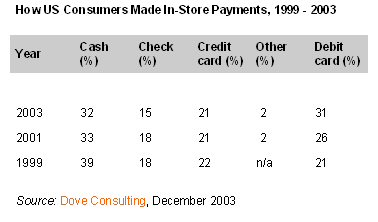
| ABOUT | ||
| SMALL BUSINESS TRENDS brings you daily updates on trends that influence the global small business market. | ||
 |
Anita Campbell, Editor | |
| Past life: CEO, corporate executive, tech entrepreneur, retailer, general counsel, marketer, HR ... (more) | ||
| email me | ||
 |
 |
||
| FREE BUSINESS MAGAZINES | ||
| Trade publications FREE to qualified professionals. No hidden offers and no purchase necessary. | ||
|
On Wall Street The Deal Computing Canada |
CIO Employee Benefit Oracle Magazine |
|
| 100+ additional titles. Click to browse. | ||
 |
| ARCHIVES & SEARCH | |||
| Previous Small Business Trends articles can be found at the links below: | |||
|
October 2003 November 2003 December 2003 January 2004 February 2004 March 2004 April 2004 May 2004 June 2004 July 2004 August 2004 September 2004 October 2004 November 2004 December 2004 January 2005 February 2005 March 2005 April 2005 May 2005 June 2005 July 2005 August 2005 September 2005 October 2005 November 2005 |
|||
|
Or, use the search box below to find a specific post: |
|||
 |
| NEWSLETTER |
| Sign up for our FREE Small Business Trends newsletter. (View Current)
We publish regularly and promise we won't share your email address with anyone. (Privacy Policy) |
 |
 |
| SMALL BIZ INFO & RESOURCES | |
 |
| BLOGS TO READ DAILY* | |
| * Don’t have time to read several dozen blogs a day? Pick two or three. Your brain will thank you for it. | |
 |
| ONLINE COMMUNITIES | ||
 |
| SPECIAL RESOURCES | ||||
| Small Business Trends Radio Tuesdays, 1:00 PM Eastern U.S. time on Voice America network Click to listen November 1st: Torsten Jacobi, CEO of Creative Weblogging, joins host Anita Campbell. Sponsored by Six Disciplines. Show details. |
||||
| Sunday, October 31, 2004 | |||||
| PowerBlog Review: E-Bitz | |||||
|
"You know what this business is like, the things you did ten years ago, five years ago are not what you do now. Heck, did we even know what Voice Over IP was a few years ago? And now more and more businesses are integrating it into their networks.There's no overt promoting of any particular business on this blog. It's not that kind of site. Rather, it shares information and in so doing demonstrates the power of the Microsoft Small Business Server technology. In many ways it's the best kind of product endorsement. It's not trying to sell anything to anyone. Because it's authentic and informational in nature, it is more powerful than any ad.
"If you hover over the image of Yoda and the Small Business Server 2003 logo you'll see why I chose it. SBS 2003 has been a bit historically the 'runt' server of the Microsoft fleet. We break every rule in the book, we don't do best practices, yet as can be seen in recent reports, the platform is selling like hotcakes. The philosophy of SBS is that it is and can be everything that a Small Business needs for a server. Yoda says 'Size matters not! Judge me by my size do you?'. The SBS 2003 logo says 'Ditto what the green guy said.' The tools that the SBS 2003 platform give a small firm are EXTREMELY powerful. It puts you on the same platform as the 'big guys'."E-Bitz is a global blog, getting visitors from across the globe. Susan blogs from Fresno, California, USA. The Power: In terms of business blogging, E-Bitz is a terrific example of using a blog to communicate with a user community and share product knowledge. E-Bitz also does a great job bridging the gap between technology and business. |
|||||
|
| |||||
 |
|||||
| Saturday, October 30, 2004 | |||||
| Why is Oz Small Business Optimistic But Not Hiring? | |||||
|
The vast majority of small business owners in Australia are optimistic that their country's good economic conditions will remain through 2005. That's according to a survey by Cashflow Manager, an accounting software firm in Adelaide, based on surveying 600 small firms. A full 92% of the 600 small firms surveyed expect conditions to either improve or remain stable over the next 12 months. However, only 27% thought they would employ more staff over the next 12 months. This article in NineMSN suggests that the reason for limited hiring plans is due to a hint of caution. But let me suggest another possible conclusion. These days, it's a common refrain among businesses of all sizes to be able to do more with fewer people. Productivity gains -- resulting from lightning fast technology advances and ever cheaper technology -- are the key reason. There was a time not so long ago that it was cheaper to hire people to do tasks than to invest in technology to drive out inefficiencies. Technology was dear. Now that situation is becoming reversed. The cost of technology keeps going down. Often the cheaper route is to purchase technology to improve business processes. So whenever I see reports of otherwise healthy economic conditions and business owners with a sense of optimism, yet with limited hiring plans, I can't help but suspect that productivity improvements play a large role. |
|||||
|
| |||||
 |
|||||
| Friday, October 29, 2004 | |||||
| Smaller Law Firms Merging | |||||
|
Mergers of law firms in the United States are up compared to 2003. Through the first three quarters of 2004 there have been 44 mergers completed. Last year there were only 35 mergers for the entire year. This information comes via Mergerwatch, a service of Hildebrandt International. At the same time, the average size of the smaller law firm involved in a merger is getting smaller. One thing this signifies to me is that more smaller firms are merging. I think they have to. It's just getting tougher to compete with larger firms for clients. The practice of law has become so complex that no one attorney can be well-versed in all the areas necessary to serve a client. That's especially true for business clients. Smaller law firms can't staff with enough legal specialists to address in depth such varied needs as trademarks, commercial law, litigation, antitrust, labor law, patents, tax law, intellectual property, creditors' rights, etc. As a result smaller firms may lose existing clients as those clients grow larger and their legal needs grow more complex. And the ability of smaller law firms to attract new clients can also be limited by their small size. Business clients want to know that a firm can bring in several attorneys across practice areas when needed on a complicated issue. As this story puts it, when a smaller firm merges with a larger one, it gets more "giddyap". It can offer more to clients. The majority of law firms are still relatively small, however -- just look in the Yellow Pages and you'll see what I mean. Small firms are not going away overnight. But look for them to gradually grow larger as the practice of law becomes more complex. |
|||||
|
| |||||
 |
|||||
| Thursday, October 28, 2004 | |||||
| The New American Dream: Start a Business | |||||
|
A recent survey by Capital One and Consumer Action finds that 40% of Americans dream of starting their own business. If 40% of Americans dream of starting a business, how does that percentage compare with other countries? This post I did earlier this year suggests that America falls somewhere in the high end, but not the highest, in the range of the most entrepreneurial countries. The United States generally would score as less entrepreneurial than many of the developing Asian countries and South America. But it tends to be more entrepreneurial than European and developed Asian countries. |
|||||
|
| |||||
 |
|||||
| Wednesday, October 27, 2004 | |||||
| The Promise of Earning Revenue from Blogs | |||||
|
Valdis Krebs (or as he is warmly known to his friends, "Valdis Who-needs-a-blog-when-everyone-blogs-about-me Krebs") sent me this link to a downloadable Morgan Stanley report about the future potential of blogs and RSS. Authored by analyst Mary Meeker (remember from the dotcom days?), the report predicts among other things, that:
|
|||||
|
| |||||
 |
|||||
| Tuesday, October 26, 2004 | |||||
| Cyber Extortion Hits Small and Midsize Businesses | |||||
|
Cyber extortion of small and midsize businesses has become the latest computer crime trend. Computer hackers target small and midsize businesses, expecting that the companies will pay up in order to keep their businesses going and stay out of the newspapers. The hackers ask for a manageable sum rather than millions of dollars, knowing it is more likely they will get paid if the sum is one the company can afford. According to a recent InformationWeek sponsored study by Carnegie Mellon University graduate student Gregory Bednarski, here is how a typical extortion attempt starts: "A typical Monday, you spend most of the morning catching up on industry reports, scheduling meetings, and reading e-mail. After answering or filing your important messages, you come across a note titled 'Customer Information', but from an unfamiliar sender. You open the message only to find a listing of your largest customers' accounts, credit, order histories, and forecasts. *** Attached to the information is a simple threat: give us cash, or this information goes public. $27,000 divided equally and deposited into three separate foreign accounts, all in a country with tenuous relations with your government, before the week's end. What do you do?"Well for one thing, you pray it doesn't happen to your company or to your IT provider. A recent attack was a nightmare for a small Cleveland IT firm, as profiled in this Craintech article by journalist Jeff Stacklin. The company ended up shutting down its computer system for a week. The company had to rebuild 40 servers and employees had to work around the clock for a week to fix the situation, to the tune of $250,000 extra expense. To top it all off, when the company did not pay up, the extortionists sent its clients emails telling them that the company had failed to secure their data. And just how prevalent is this cyber crime? The InformationWeek study referenced above showed that of the companies surveyed, 17% had a cyber-extortion threat made against them. In 18% of those cases, the extortion attempt was an inside job, involving an employee. And in 41% of cases the victimized company was not even pursuing identification of the extortionist, a figure which implies that some cyber crimes go unreported -- or at least that the criminals get away with it. |
|||||
|
| |||||
 |
|||||
| Monday, October 25, 2004 | |||||
| IBM Pursuing SMB Market in China | |||||
Small Business Computing reports that IBM is going after the small and midsize business (SMB) market in China:"The SMB market in China is red hot, which isn't in line with a country known more for its super-size, government-sponsored companies. According to IBM researchers, 99 percent of Chinese businesses can be categorized as SMBs, while the Chinese SMB market makes up $4 billion to $5 billion of the $300 billion global SMB market.IBM's efforts will center around its recent launch of an Innovation Center in Beijing. The Innovation Center assists software partners that will use IBM's middleware platform to provide solutions to China's SMBs. This is interesting because the news involves two converging hot areas: the SMB market and China. As the Chairman of a board that I am on said to me recently "small business is where it's at today." I'd add "China is also where it's at." |
|||||
|
| |||||
 |
|||||
| Sunday, October 24, 2004 | |||||
| PowerBlog Review: Proposal Writing Blog | |||||
|
"Today was a sad day for one of my long-time clients. She received a letter from the Centers for Disease Control (CDC) which said that another firm had been awarded a contract for which she had submitted a bid way back in March (yes, it took that long for the contract to be awarded). My client was pretty sure that she had won this contract -- the government auditors had paid her a visit and reviewed her books, she had done well during oral discussions, and she had a sense of "good vibrations" in subsequent discussions with the Contracting Officer. But alas, it was not to be. She came in second.Deborah blogs from Columbia, Maryland, USA, between Baltimore and Washington, DC. The Power: Between Deborah's Proposal Writing Blog and her commercial website, you'll find an awesome volume of great content. That is one of the shining stars of this blog -- difficult-to-find content that is incredibly useful and made all the more convenient because it can be found in one place. |
|||||
|
| |||||
 |
|||||
| Saturday, October 23, 2004 | |||||
| Temporary Stores a Growing Trend | |||||
|
"Is it just me, or are people making a bigger deal out of Halloween than they used to?"No, it's not just a law professor in Tennessee noticing Halloween. It's happening all across America. Halloween has become a big deal in the United States. Halloween sales are expected to reach US$3.12 Billion this year, according to the National Retail Federation. A survey by the Macerich Company (a REIT which invests in shopping malls) says that a majority of Americans (59%) plan to participate in Halloween this year. That's a pretty amazing figure, when you consider that roughly the same percentage (60%) are expected to come out to vote for the leader of the free world -- and 60% voter turnout would be close to a record in recent years. This unprecedented interest comes to a holiday that started out 25 centuries ago in Celtic Ireland, where it marked the end of harvest time and the start of winter. In medieval times the holiday coincided with the eve of All Saints' Day. The name "Halloween" comes from medieval England's All Hallows' eve (Old Eng. hallow=saint). In places across America -- like Des Moines, Iowa and Akron, Ohio -- the retail landscape is changing as a result of the interest in Halloween. First of all, it is driving a trend toward large superstores opening seasonally just to sell Halloween goods. This report by Patt Johnson of the Des Moines Register summarizes it: "No longer are discount stores and small seasonal shops enough for some fright-night fans. This year in Des Moines, at least four superstores have opened, joining mass merchandisers and other shops that offer goods for Halloween, Oct. 31.This trend toward large superstores opening up for temporary sales is sure to change the dynamics for smaller costume shops and smaller retailers. On the one hand, these superstores can be stiff competition for smaller, local independents. In typical "big box" fashion, with their huge sourcing power, they offer a large selection at prices most smaller retailers cannot afford to compete with. On the other hand, all the visibility and marketing by these superstores increases the interest in Halloween overall. On the theory of a rising tide raising all ships, it can lead even family-owned costume shops to higher sales. The growth in temporary Halloween stores also signals a change in the real estate landscape. In recent years, landlords have warmed to the idea of temporary tenants coming in to sell just for a holiday season or limited time. Temporary leasing has become a US$10 Billion per year industry. Temporary tenants are becoming an important niche for retail real estate, as this article by Mary Etheridge in the Akron Beacon Journal suggests: "In February of this year, Circuit City closed its Fairlawn big-box store, leaving the city with a gaping hole in its otherwise healthy retail landscape.Temporary tenancy also has its positive side for entrepreneurs and budding retail businesses. It presents a chance for entrepreneurs to test market. As the same article notes, quoting Patrice Duker, spokeswoman for the International Council of Shopping Centers: "Temporary tenancy is also a chance for entrepreneurs to test concepts or capitalize on what's hot without a long-term commitment, said Duker.[UPDATE: I realized after posting this that more people will be participating in Halloween this year than are expected to vote, because the 60% voter turnout would be measured just on registered voters, not the entire population.] |
|||||
|
| |||||
 |
|||||
| Friday, October 22, 2004 | |||||
| Small Businesses say "We are Optimistic" | |||||
American Express this week came out with the fall edition of its Small Business Monitor survey. The results? They show small U.S. businesses are optimistic about the economy right now:"According to the survey, nearly three quarters (74%) of business owners foresee growth opportunities for their companies in the next six months, similar to last year, and up from 64% in October 2002. In addition, fewer have a negative outlook about their near-term business prospects. Fourteen-percent say they expect the economic climate to negatively affect their businesses (vs.17% last year and 21% in 2002).The Small Business Monitor is a semi-annual survey conducted of businesses with under 100 employees. The latest survey was completed during September 2004. |
|||||
|
| |||||
 |
|||||
| Thursday, October 21, 2004 | |||||
| Stay-at-Home Moms: The New Entrepreneurs | |||||
Today's Wall Street Journal (requires subscription) has a front-page article about professional women who become stay-at-home mothers and then start their own businesses:"Tamara Monosoff, a former business consultant and Clinton White House staffer, quit work to stay at home when her daughter Sophia was born. Then she found herself annoyed by the constant need to re-roll the toilet paper Sophia unraveled onto the floor.The article suggests that the number of professional women who decide to quit their jobs and become stay-at-home moms is on the rise. I don't know about that statistic, but one thing that I am seeing is a growing number of websites and networked communities of women -- especially young mothers -- who have started home-based businesses. The websites keep the motivation high and provide friendship for women who might otherwise feel isolated by being at home with young children. Think of the sites as a sort of 21st century version of the coffee klatch. [UPDATE October 27: Thanks to Jeff Cornwall who alerted us that everyone can read the entire WSJ article because it is now free access at Startup Journal.] |
|||||
|
| |||||
 |
|||||
| Wednesday, October 20, 2004 | |||||
| RFID, Small Businesses and Terrorism | |||||
 "An associate of Osama bin Laden crawls into a container -- along with some new luxury cars -- in a shipyard in Hamburg, Germany. The goal -- shipping himself to the United States and evading the Department of Homeland Security, with its high-tech officers on the ground at major airports, armed with databases of suspects' photos. "An associate of Osama bin Laden crawls into a container -- along with some new luxury cars -- in a shipyard in Hamburg, Germany. The goal -- shipping himself to the United States and evading the Department of Homeland Security, with its high-tech officers on the ground at major airports, armed with databases of suspects' photos.He is foiled, however, when a silent alarm is triggered, and an alert is sent to security over the airwaves, as he lifts the lid of the container in the warehouse. A wireless radio frequency identification or RFID security tag on the container sent the signal, silently, without alerting the intruder." So starts an interesting article outlining a multitude of ways that RFID can be used to fight terrorism. The Department of Homeland Security, the Pentagon, and the U.S. Congress, are evaluating, piloting or using RFID in numerous applications. A reader emailed me this past week asking where he could get a grant for RFID. Small businesses in the United States with promising RFID applications that could have anti-terrorism uses will probably find their best bet to be Small Business Innovation Research (SBIR) grants. SBIR grants are good for furthering R&D efforts and raising seed money. Good places to start would be the Department of Defense SBIR website and the Homeland Security SBIR website. Next year's SBIR solicitation for projects at Homeland Security will be pre-announced in just a few weeks. The website even has a counter to count down the days until the grant application deadline (about 90 days from now). Editor's note: this post originally appeared on my other blog, the RFID Weblog. I am reproducing it here because I thought it might be of interest to readers of Small Business Trends. For more information about radio frequency identification (RFID), my other blog might be worth checking out. |
|||||
|
| |||||
 |
|||||
| Tuesday, October 19, 2004 | |||||
| Japan's SMEs Hot on IPO Trail | |||||
|
This interesting news is out of Japan: the initial public offering (IPO) market for small and medium enterprises (SMEs) in Japan is red-hot.
As a case in point, two acquaintances with a thriving media business dropped by last week. They have the happy knack of being able to produce high-quality magazines and web content and have turned it into an outsourcing business. Their Japanese clients believe that you can't communicate with customers unless you're engaging them with original material and thus business is pouring in -- to the point that they will double sales next year. At the current rate, and they're already profitable, they will meet the requirements to IPO their company in 2007. A few weeks ago, they were noticed by a local securities company, a second tier firm which picks up IPO candidates and tries to hook them in before a major firm appears, and which suggested that our friends start preparing for an IPO. Although they'd never considered going public as a reality before, being buried in the minutae of running a company and making a profit, the effect on both them and their staff has been galvanizing. Now, for the first time, they are thinking about taking in a second stage of funding, and even looking at taking over one of their competitors to bulk up their business. The IPO buzz in their office is tangible, and everyone is riding a high -- needless to say, their productivity is really pumping. Is this a good thing? Well, on one hand it smacks of bubble mentality, and one has to ask whether every (and it is virtually every) profitable company with revenue exceeding JPY1bn ($9m) has the wherewithal to go public and withstand the costs and public scrutiny. In particular, those trying to push the growth of their companies beyond the natural (organic growth) limits may find it hard to deal with any market downturns and other setbacks. Outside IPO-focused investors do not sit idly by when the numbers are missed -- and many aspiring CEOs will find this hard to take. But on the other hand, getting rich is a great incentive and Japan's conservative SMEs are opening up. CEO's everywhere are dreaming dreams they haven't allowed themselves to have before -- and this is exciting. It means a much better circulation of ideas and intellectual property, more inventions being launched, more cross-fertilization with foreign firms, and generally an acceptance of outside resources if those resources mean a competitive edge and a better shot at the IPO market. So probably the most relevant question left is: will the stock markets in Japan stand up to this kind of massive welling up of IPO candidates? The next couple of weeks will tell, as three massive IPOs come to fruition. However, we believe that these bigger IPOs will draw a different type of investor and so those in the market to buy into smaller IPOs will still be there and be active. There have been some comments in the media about market worries that the IPO market might be softening, such as in the case of candy maker Sansei, whose market price opened lower than its pre-IPO price on the first day of trading. However, despite all the handwringing, not one week later another company, GF Ltd., stormed out the gates with an amazing 270% first-day gain on its pre-IPO price -- showing that the good times are still with us. |
|||||
|
| |||||
 |
|||||
| Monday, October 18, 2004 | |||||
| Carnival of the Capitalists -- Check it Out | |||||
|
Here at Small Business Trends we participate in a weekly business event that travels from blog to blog, called Carnival of the Capitalists. Carnival of the Capitalists showcases business articles from a variety of excellent blogs from around the globe. It's a superb way for you, the reader, to discover new blogs. You will find articles by professors, published authors, attorneys, small business owners, economists, consultants, CPAs, industry experts, and those who are simply interested participants. This week's Carnival is at Accidental Verbosity. Next week Carnival will be over at The Big Picture. If you would like to submit an article or become a host, visit the Carnival home page. |
|||||
|
| |||||
 |
|||||
| Sunday, October 17, 2004 | |||||
| PowerBlog Review: Southern California Real Estate Blog | |||||
|
"We do not know if blogging has actually helped our real estate business. Actually, no client has ever told us they have read our blog. Our purpose is not to get business ... you will note there is no commercializing on our blog. No ads for us nor for our listings. Our purpose is to give information about real estate and related topics."One of my favorite things about this blog is how consistent -- and consistently useful -- it is. Fran, who does most of the blogging, posts every other day. This is exactly as a blog should be, with dedicated posting on a regular schedule. Just consider how many "living dead" blogs are out there, that haven't been updated in weeks or months, and you'll know what I mean. Fran and Rowena have kept at it for about a year. The Power: The Power of the Southern California Real Estate Blog is in its dedication to providing useful real estate information and not hard selling. It's by two real estate professionals who know their profession well and who serve the public and other professionals equally well. |
|||||
|
| |||||
 |
|||||
| Saturday, October 16, 2004 | |||||
| Explaining Marketing to Small Business Owners | |||||
|
The small business owners I know are always using phrases like "cut to the chase," "let's get to the bottom line," and "give me the headlines." They may wear multiple hats and have a hundred distractions in a day's work. They tend to value service providers and vendors who distill information down into understandable, memorable bites. A little humor never hurts, either. So when I found the following post on a French blog, Fplanque: IT trends weblog, I thought it was apropos to reproduce here at Small Business Trends: "I received the following in a spam, but I thought it was an interesting image: |
|||||
|
| |||||
 |
|||||
| Friday, October 15, 2004 | |||||
| Big Banks Getting Bigger Share of Small Businesses | |||||
Today's Kiplinger Letter (subscription required) says U.S. national and regional banks are going after small businesses:"Small businesses are being wooed by national and regional banks seeking a bigger piece of a market once ruled by community banks. Already, nearly half of smalls' loans are held by the 58 largest banks. And the bigger banks are pushing corporate credit cards for small firms. Card numbers will top 12 million by year end, up from 4 million in 2000."About six months ago I wrote here that big banks were actually better for small business than small community banks. Mostly it is because big banks can offer services that community banks do not have the resources or mindset to offer, such as free online banking. So, I am not at all surprised by Kiplinger's trend forecast. I'd like to think that smaller banks with personalized service can compensate for limited technology and the kind of economies of scale that big banks can offer -- but I'm afraid it isn't so. |
|||||
|
| |||||
 |
|||||
| Thursday, October 14, 2004 | |||||
| Segmenting "Small Business" for IT Needs | |||||
|
With so many small businesses worldwide, it's no wonder that large IT providers are going after the small business market. CRN magazine has an interesting piece about Cisco's efforts to move down market and sell to small businesses. Cisco will be competing -- at least in part -- against lower priced vendors including its own Linksys division. I think Cisco has taken a very smart approach to this market (although I may be the only one other than Cisco who thinks so -- the article itself sounded doubtful). Cisco has segmented the small business market according to buying behaviors -- instead of the more typical employee size and/or revenue size. CRN magazine (subscribe free) says: Cisco is targeting the SMB segments that are looking for high value and high feature sets, he said. Cisco breaks the market into four tiers: enterprise adopters, or small businesses that behave like enterprises; cutting-edge adopters that value technology and use it as a strategic advantage; value-price adopters that use technology but are driven by price; and "laggers," companies that adopt technology late in the cycle because they have to remain competitive.Meanwhile, as Cisco approaches the SMB market from the high end, its Linksys division is making headway moving up from the low end. Linksys seems to be proving a philosophy I've long held: that it is easier to take a low-end tech product and move up market, than to adapt a full-featured premium-priced product to move down market. For a crisp explanation of this behavior-based segmentation visit the AMI Partners website. [UPDATE: link now fixed] |
|||||
|
| |||||
 |
|||||
| Wednesday, October 13, 2004 | |||||
| On The Value of Trend Spotting | |||||
 A recent Knowledge@Wharton article outlines the eight attributes of leadership in the book, Lasting Leadership. A recent Knowledge@Wharton article outlines the eight attributes of leadership in the book, Lasting Leadership. Attribute number 4 caught my eye: They can "see the invisible" - that is, spot potential winners or faint trends before their rivals or customers.This pretty much sums up the purpose for the site here at Small Business Trends. I think trend spotting is a fundamental way to stay ahead of the competition and anticipate new opportunities. Hat tip TJ's Weblog. |
|||||
|
| |||||
 |
|||||
| Tuesday, October 12, 2004 | |||||
| When Cooking Becomes a Hobby (We Hire Others) | |||||
Cooking will one day be a hobby in the U.S., rather than a daily necessity. So predicts Harry Balzer, who for 26 years has tracked food trends for market research firm NPD Group: "Cooking overwhelms almost everyone. You eat several times a day, and it's a job to get food that many times," he says. He compares cooking today to sewing in the '50s and '60s. Back then, many people made their own clothes. Now most people who sew do it as a hobby. The same thing will happen to cooking, he predicts.We can see where this consumer trend leads: more restaurant meals and prepared foods. And of course this in turn leads to corresponding business opportunities, many of them in the small business market. It's good news for restaurants, catering services, food service companies, personal chefs and other businesses that absorb the burden of cooking. All of which adds to the ever-increasing services sector of the U.S. economy. Services make up the majority -- over half -- of the U.S.'s economy (GDP). We are a nation willing to pay others to do for us the things we no longer care to do ourselves. |
|||||
|
| |||||
 |
|||||
| Monday, October 11, 2004 | |||||
| How Harley Davidson Lost its "Cool" | |||||
|
Editor's note: we are pleased to present another article by expert guest blogger, John Wyckoff. He explains why Harley Davidson is no longer "cool" ...and profiles the new kind of competition. And how reality TV is fueling the trend. By John Wyckoff The famed motorcycle designer, Arlen Ness and I were chatting at a trade show recently. Our subject was what was "cool." Arlen reminded me that a few decades ago if you had a Harley-Davidson in your garage that alone made you cool. "Not any longer," he told me. "Now Harley-Davidson is just another bike. They lost their 'cool'." There are new players in the motorcycle "cool" market. Big Dog Motorcycles and American IronHorse are two of the biggest "cool" bike makers. Big Dog Motorcycles have produced over 10,000 bikes and American IronHorse a bit under that. The big question is what's happening? Why the paradigm shifts?  Here's what I see. First, the Alpha buyer, those leading edge buyers, got to have the coolest, baddest, biggest.... They don't want a bike that looks like anyone else's. They want to stand out in the crowd. Even in a crowd of fellow bikers. They've concluded you can't do that on a stock Harley and even a custom Harley really doesn't cut it. Here's what I see. First, the Alpha buyer, those leading edge buyers, got to have the coolest, baddest, biggest.... They don't want a bike that looks like anyone else's. They want to stand out in the crowd. Even in a crowd of fellow bikers. They've concluded you can't do that on a stock Harley and even a custom Harley really doesn't cut it. An old friend of mine is responsible for most of the growth of American IronHorse. His name is Bob Kay, and he knows more about V-twin motorcycles and their owners than most of the folks at the Harley factory. His company makes bikes that "start where Harley leaves off." Their engines are bigger, the rear tires wider, the paint unbelievably complex and graphic, with raked forks, polished alloy wheels and a mass of machined billet parts. The prices start where Harley-Davidson leaves off too. When I visited Big Dog Motorcycles last year and photographed the bikes ready to be shipped to dealers I was impressed by the fact that of the hundreds staged in the shipping area there were NO TWO ALIKE. High tech abounds in both manufacturers. Electronics are state-of-the-art. Teams of artists and dedicated technicians create the one-off paintwork. Both these companies occupy the narrow, top of the pyramid of custom bikes. Why all the interest? Bike build-offs and custom choppers shown on Discovery and Speed Channel on cable TV have attracted millions of viewers. They show the creation of one-off bikes while the viewer watches. They show the camaraderie and accessibility of the bikers and the creators. They make the viewer want to be a part of this unique world. The bike shows are like reality TV, only ... more real. What you don't see are the prices. The bikes they produce are in the six-figure range and are more artwork than roadwork. The "Chopper" is having a rebirth. Why? They're cool. No, I'm not a chopper guy. I like creature comforts like a suspension system that works on both the front and rear of the bike, a seat that allows me to ride long distances and a riding position that doesn't cause pain. I'm not alone. American IronHorse, Big Dog Motorcycles and other entrants like Viper, also make a limited number of very comfortable, very high quality, high-performance V-twin bikes. From a marketing perspective these two companies (and soon several more) are like Ferrari and Lamborghini; high priced, high performance, attention getters. They too are in short supply. Big Dog Motorcycles and American IronHorse tell me they are sold out through the spring of 2005. Is this concept new? No, it's not. Baton Advertising Handbook published by Prentice-Hall back in 1950, talks about a success formula by dealing in the fringe area of the mass market with a unique product. That's what these two companies do and why they are successful. By the way, this book remains my marketing bible. |
|||||
|
| |||||
 |
|||||
| Sunday, October 10, 2004 | |||||
| PowerBlog Review: Horsefeathers | |||||
|
|
|||||
|
| |||||
 |
|||||
| Saturday, October 09, 2004 | |||||
| Advertising Trend Requires Gritty Truth | |||||
|
Roy H. Williams, founder of the Wizard of Ads Academy, says that the nature of advertising will change in the United States over the next five years. And it is all being driven by demographic changes. The generation following the Baby Boomers and ascending into consumer prominence now, has a different view of themselves and what they value. They have a "quiet demand for gritty truth." As a result, expect traditional advertising to be less effective in the future. His advice to businesses? Be more real and genuine in your approach to advertising: "Focus less on instant-response, promotional advertising and become the store customers think of immediately when they need what you sell. The new trend in advertising is away from hype and romanticism and more toward facts and truth."Excerpted from Michele Miller's WonderBranding blog, where she reproduces the entire article here. |
|||||
|
| |||||
 |
|||||
| Friday, October 08, 2004 | |||||
| Big Tech Buying Small Tech Trend | |||||
In a recent Business 2.0 article, Om Malik identifies a new trend that has largely gone unnoticed until now: giant tech companies buying up very small tech startups once they start to get some traction. He points to:"...an emerging breed of here-today, bought-tomorrow startups that are sprouting with minimal funding, flowering briefly, and being gobbled up by far bigger companies. In many instances, these built-to-flip outfits forgo -- or sometimes can't get -- money from venture capitalists. They instead create shoestring operations focused on the rapid development of narrow technologies to plug gaps in existing product lines or add useful features to existing products. Then they look to a deep-pocketed patron to scoop them up.Jeff Cornwall at The Entrepreneurial Mind approves, pointing out how this trend differs from the "get rich quick" attitudes during the dotcom boom: "True entrepreneurship is about addressing real needs, building value, creating jobs, fueling the economy, building strong communities, and creating real wealth for those who take on the risk of investment. *** Instead of raising money just because they can, these folks are now looking for real opportunities, bootstrapping them, and finding a way to help them grow. While I am a little concerned about the "flipping" part, at least they are getting the first steps right this time."I would add this thought: it is a lot more satisfying to build a business through bootstrapping than through VC money. Seeking venture funding is itself a full-time job. Tech entrepreneurs have to ask themselves: would I rather spend my time pitching VCs to invest in my company, or would I rather spend my time on the things I love, like developing new technology? Because, when it comes down to it, very few companies are good candidates for venture capital. As I reported a few months ago, according to the Global Entrepeneurship Monitor, globally fewer than 38 out of 100,000 companies were funded by venture capital in 2002. Out of those, fewer than 10 were seed-stage and even fewer were newly started companies. |
|||||
|
| |||||
 |
|||||
| Thursday, October 07, 2004 | |||||
| A New Trend: Even-it-Up In Time of Need | |||||
|
|
|||||
|
| |||||
 |
|||||
| Wednesday, October 06, 2004 | |||||
| How the Internet Helped Small Airlines Surge | |||||
|
"All along, US Airways endured, thanks to its ability to charge extremely high fares to businesspeople. But the rise of the Internet undermined this advantage. Previously, only travel agents had access to computerized reservation systems. But with pricing information available at the click of a mouse, passengers could quickly find a $200 ticket on a route for which US Airways wanted to charge $2,000. In many fliers' minds, the mileage awards, airport lounges, first-class cabins and other amenities offered by the big carriers no longer justified the higher fares." |
|||||
|
| |||||
 |
|||||
| Tuesday, October 05, 2004 | |||||
| Virtual Workplace Trend Changes Business | |||||
|
For some time now we have been pointing out how small businesses are leading the charge toward the virtual work environment. This is a significant trend sweeping the USA and other developed nations. In this excerpt from an HR.com article (registration required), Ralph Gregory, founder of the Intelligent Office emphasizes just how far-reaching this trend is today: "Going to work" is becoming old school. "Work" is now something you do and no longer a location. The growth of telecommuting, home-based businesses, cell phones, laptops and other mobile means is mute testimony to the idea that more and more people are leaving the traditional office behind. ...John Challenger, CEO of Challenger, Gray & Christmas, Inc., an international outplacement consulting firm, predicts "telecommuting will be the predominant workplace trend in the next 20 years." Just today I had a business discussion involving how to sell to small businesses in the 21st century. It's a challenge to cost-effectively reach the small business market with a marketing message or sales pitch, especially when so many small businesses operate virtually. Do you go through channel partners that already have relationships with small businesses? How about reaching small businesses online? Are referrals from other small businesses the right answer? Or what about marketing near or locating next to retail outlets that small businesses frequent, such as the local Kinko's, Office Max, Post Office or Starbuck's? The small business market has always been a tough one to crack because it is so fragmented. The virtual business trend adds to the challenge and requires thinking outside the box. |
|||||
|
| |||||
 |
|||||
| Monday, October 04, 2004 | |||||
| Goodbye, Check Float | |||||
Jim Blasingame of the Small Business Advocate points out that the check float that so many U.S. consumers (and small businesses) have relied upon will soon be gone. Go for that overdraft protection your bank offers, he says. You may need it by the end of October:"...[T]he 'Check Clearing for the 21st Century Act,' or 'Check 21,' was passed, and will go into effect on October 28, 2004.With no float time left, one of the last major advantages of writing paper checks in the retail environment will be gone. Of course, this shift from paper checks to electronic transactions has been taking place for years --driven by convenience -- as this chart, showing in-store transactions in the U.S. illustrates (via ePayNews.com):  UPDATE October 8: I cross-posted this article over at Blogcritics.org, and got some interesting comments. Join the conversation over there. |
|||||
|
| |||||
 |
|||||
| Sunday, October 03, 2004 | |||||
| PowerBlog Review: Hispanic Trending | |||||
|
"As each successive wave of immigrants has come to America and taken its place in the economic mainstream, with time, its attitudes and preferences have changed. It only stands to reason that the concerns of a recent immigrant will change greatly as that individual buys a home, opens a business and raises a family in the new country. The Power: The Power of the Hispanic Trending blog is in its comprehensive coverage of trends, news and events involving Hispanics in the United States. Hispanic Trending raises our awareness of the growing importance and influence of Latinos, and helps us understand this population segment far better than we did. |
|||||
|
| |||||
 |
|||||
| Saturday, October 02, 2004 | |||||
| Small Business Optimism Index High | |||||
Small businesses in the United States are optimistic about the economy, according to the National Federation of Independent Business (NFIB) Optimism Index:"The Small Business Optimism Index for August hit 102.9 (1986=100), continuing a 17-month string of 100 or above readings. The August reading was only 3 points lower than that of the near-record breaking month of July and showed no signs of weakness in the overall numbers. The outlook remains good for growth from the perspective of small business which produces half of the private sector's GDP."  From the NFIB Small Business Economic Trends Report for September 2004. |
|||||
|
| |||||
 |
|||||
| Friday, October 01, 2004 | |||||
| Late Bloomers Buying Franchises | |||||
|
Entrepreneur magazine has a profile of older entrepreneurs who decide to buy franchises in their 50's and later:
"Don't assume 50-year-olds are past their prime - many are finding that the years after 50 are a perfect time to start a business, and buying a franchise is a great way to do that. Whether motivated by personal desire or out of financial necessity, these ambitious individuals are pursuing entrepreneurial endeavors in every imaginable field. Here's a look at several late-blooming entrepreneurs who purchased a franchise after age 50."The article points out some of the reasons that older individuals are starting businesses. Today's older population is healthier and more active. Many of them expect to work longer rather than retire. And, as one entrepreneur in the article points out, starting a business or buying a franchise gives new meaning to your life. Of course, some time ago we spotted this trend toward older individuals starting businesses. We call it the "Graying of Small Business" and we've written about it over at our sister site, TrendTracker. [Hat tip to Dane Carlson at Business Opportunities for the link.] |
|||||
|
| |||||
 |
|||||
 |
 |
||||
| More news... more trends... more insight... | |||||
| Home | Privacy | Terms | SmallBizTrends |
| (c) Copyright 2003 - 2005, Small Business Trends LLC. All rights reserved. |
 Editor's note: It's time once again for another PowerBlog Review of a business weblog! This is the thirty-seventh in our popular weekly series.
Editor's note: It's time once again for another PowerBlog Review of a business weblog! This is the thirty-seventh in our popular weekly series.  No review of E-Bitz would be complete without a few words about the blog's logo - Yoda, from Star Wars. When I asked her about it, Susan told me she is a HUGE fan of Star Wars. And Yoda has special significance according to Susan:
No review of E-Bitz would be complete without a few words about the blog's logo - Yoda, from Star Wars. When I asked her about it, Susan told me she is a HUGE fan of Star Wars. And Yoda has special significance according to Susan:
 A few weeks ago Instapundit asked
A few weeks ago Instapundit asked 
 Horsefeathers is a long-established restaurant that spends much of its advertising budget on loyalty marketing, the emphasis being on maintaining their present customer base. Because they are located in a resort town just starting to see the influx of chain restaurants, the owners felt they needed a tool to stay in touch with regular customers before they were lost to the chains. The tool of choice was a weblog.
Horsefeathers is a long-established restaurant that spends much of its advertising budget on loyalty marketing, the emphasis being on maintaining their present customer base. Because they are located in a resort town just starting to see the influx of chain restaurants, the owners felt they needed a tool to stay in touch with regular customers before they were lost to the chains. The tool of choice was a weblog.  Editor's Note: We are very pleased to have the following trend spotting report from
Editor's Note: We are very pleased to have the following trend spotting report from 
 This is a super resource for finding just about anything that deals with Hispanics and Hispanic culture, attitudes and behaviors.
This is a super resource for finding just about anything that deals with Hispanics and Hispanic culture, attitudes and behaviors. 